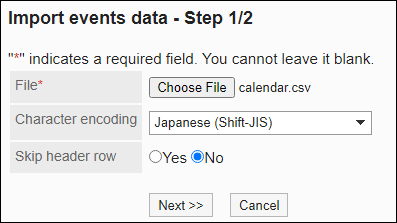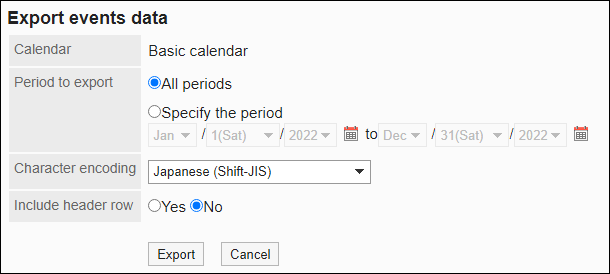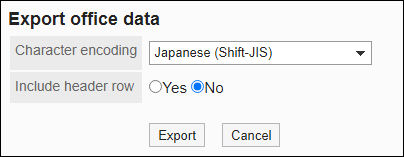Managing Data Using Files
You can manage calendar data using CSV files.
The following data can be managed using CSV files:
- Events
- Office Information
- Office Name
Managing Events Using CSV Files
You can manage events using CSV files.
Importing Data from a CSV File
You can import events from a CSV file.
Data imported from a CSV file is added as new events. Events that have been added to Garoon are not overwritten by the contents of the file.
If an error occurs while importing a CSV file, the import process will be terminated. The data which has been imported will be eliminated.
-
Create a CSV file to import data.
For information on items that can be managed using CSV files, refer to the CSV format in Calendars. -
Click the Administration menu icon (gear icon) in the header.
-
Click System settings.
-
Select "Basic system administration" tab.
-
Click Calendar.
-
Click Calendar settings.
-
On the "Calendar Settings" screen, select a calendar and click Import events data.

-
On the screen to "import events step 1/2", select the CSV file that you created in step 1.
-
Set the required items for the data to import, and then click Next.
The setting fields are as follows:
- Character encoding:
Encodes data from a CSV file with the selected character code.
The following character encoding can be selected:- Unicode (UTF-8)
- Japanese (Shift-JIS)
- ASCII
- English (Latin1)
- Simplified Chinese (GBK/GB2312)
- Thai (TIS-620)
- Skip the first row:
If the header row contains information other than data such as an item name and a comment, select "Yes".

- Character encoding:
-
On the screen to "import events step 2/2", check the contents of the CSV file, and click Import.
Exporting Data to a CSV File
You can export events to a CSV file.
-
Click the Administration menu icon (gear icon) in the header.
-
Click System settings.
-
Select "Basic system administration" tab.
-
Click Calendar.
-
Click Calendar settings.
-
On the "Calendar Settings" screen, select a calendar and click Export events data.

-
On the screen to export events, set the required items for the exported data.
The setting fields are as follows:
- Period to export:
Specify all periods or a period to export. - Character encoding:
Encodes data from a CSV file with the selected character code.
The following character encoding can be selected:- Unicode (UTF-8)
You can select with BOM as required. - Japanese (Shift-JIS)
- ASCII
- English (Latin1)
- Simplified Chinese (GBK/GB2312)
- Thai (TIS-620)
- Unicode (UTF-8)
- Include header row:
To export an item name to the header row of a CSV file, select "Yes".

- Period to export:
-
Confirm your settings and click Export.
-
Save the file with a function provided by your Web browser.
Managing Office Data in CSV Files
You can manage office information and office names using CSV files.
Importing Data from a CSV File
You can import office information and office names from a CSV file.
If an error occurs while importing a CSV file, the import process will be terminated. The data which has been imported will be eliminated.
-
Create a CSV file to import data.
For information on items that can be managed using CSV files, refer to the CSV format in Calendars. -
Click the Administration menu icon (gear icon) in the header.
-
Click System settings.
-
Select "Basic system administration" tab.
-
Click Calendar.
-
Click Import from CSV file.
-
On the "Import from CSV File" screen, select data to import from a CSV file.
-
Select the CSV file that you created in step 1.
-
Set the required items for the data to import, and then click Next.
The setting fields are as follows:
- Character encoding:
Encodes data from a CSV file with the selected character code.
The following character encoding can be selected:- Unicode (UTF-8)
- Japanese (Shift-JIS)
- ASCII
- English (Latin1)
- Simplified Chinese (GBK/GB2312)
- Thai (TIS-620)
- Skip the first row:
If the header row contains information other than data such as an item name and a comment, select "Yes".

- Character encoding:
-
Confirm the CSV file contents and click Import.
Exporting Data to a CSV File
You can export office information and office names to a CSV file.
-
Click the Administration menu icon (gear icon) in the header.
-
Click System settings.
-
Select "Basic system administration" tab.
-
Click Calendar.
-
Click Export to CSV file.
-
On the "Export to CSV File" screen, select data to export to a CSV file.
-
Set the required items for the data to export.
The setting fields are as follows:
- Character encoding:
Select the character code that you want to use for encoding.
The following character encoding can be selected:- Unicode (UTF-8)
You can select with BOM as required. - Japanese (Shift-JIS)
- ASCII
- English (Latin1)
- Simplified Chinese (GBK/GB2312)
- Thai (TIS-620)
- Unicode (UTF-8)
- Include header row:
To export an item name to the header row of a CSV file, select "Yes". - Language in which the data is exported:
This item is displayed when you export the display name of the office.
The office name will be exported to a CSV file in the language that you select.
You can select multiple languages. The following languages can be selected:- All
- 日本語
- English
- 中文(简体)
- 中文(繁體)
Exported in Traditional Chinese.

- Character encoding:
-
Confirm your settings and click Export.
-
Save the file with a function provided by your Web browser.